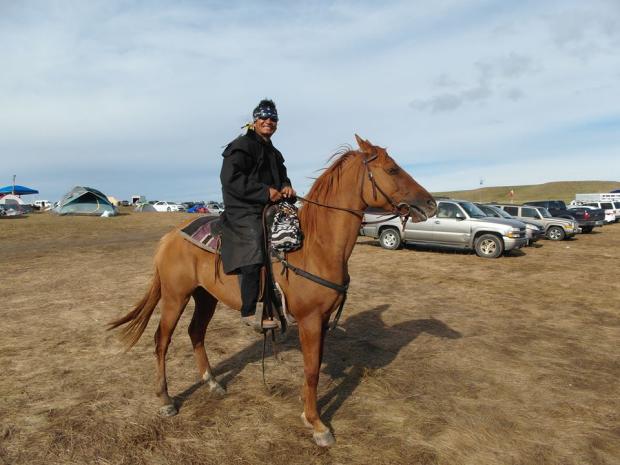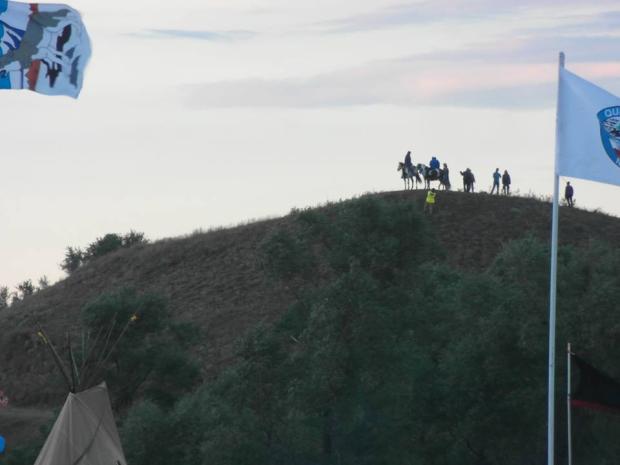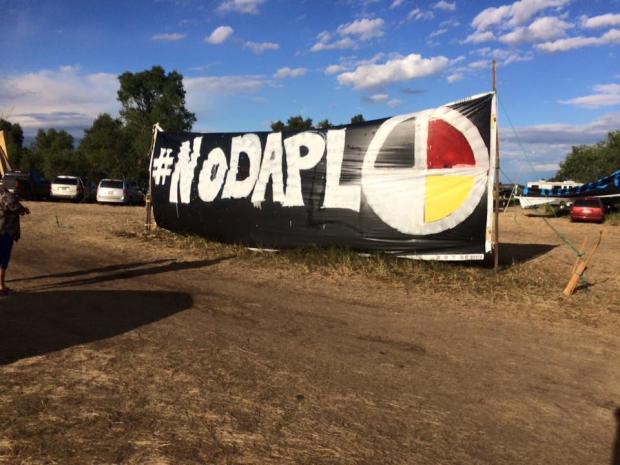Standing Rock is the focal point of a struggle between the indigenous people of the United States and the big oil industry. Energy Transfer Partnership is building the Dakota Access Pipeline that will transport Bakken fracked oil to the Gulf of Mexico and then likely sold outside this country. The pipeline is planned to go right under the Missouri River just one half mile upstream of the Sioux Reservation. The Missouri is the main source of water for the people on the reservation, as well as approximately 13 million people downstream.
Via social media, I was shocked to see video footage of natives being attacked by guards with pepper spray and vicious dogs as they tried to peacefully defend their sacred burial grounds from bulldozers. I became resolute that I wanted to go to the Standing Rock Reservation in North Dakota.
On September 8th I arrived in North Dakota. As I drove down route 6 into the reservation, I started to see small camps along the road next to areas that had been disturbed by bulldozers. A little farther and I saw hundreds of flags lining a long road into the camp. The land was covered in tepees and bright colored tents.
I pulled into camp and was immediately directed to an area where I began to set up camp. Once my tent was up, I headed to the main meeting area where I met a large group of people heading for the river. Coming down the stream was a parade of canoes from different tribes. The canoe members were dressed in their traditional costumes and were singing and drumming. The crowd on the bank erupted into yelps and cheering. This was just one of many signs of solidarity.
My first night at camp was like being transported back in time. I fell asleep to drums and singing coming from several different camps within the Standing Rock gathering. The drums beat and the horses called to each other through the night.
The next morning, I participated in the march to the burial grounds that had been attacked by bulldozers the week before. Friday was the day that the announcement was supposed to come regarding the Sioux request for injunction filed in Federal Court. It was not known what the response would be after the decision. We marched a mile down the road. A young woman pushed an elder in a wheelchair up several hills to get to the burial ground. It was a difficult walk; I did not envy her task. Once there, several prayers were sung as we held hands, a pipe was passed among those gathered and there was an excited cry as someone pointed to an eagle flying overhead; it was my understanding that this was a good sign. At this gathering no one cared whether you were native or white; everyone standing with the tribe was accepted. Unity was the powerful message.
Within a few hours of returning to camp, cheering erupted at the main meeting area. I headed to the area to find out what had happened. Upon arriving I could see the smiles on everyone’s face as I learned that even though the tribe had not received relief from the court system, President Obama’s administration had issued a directive that was seen as a victory by the Sioux. I was privileged to participate in the celebratory singing and dancing as we celebrated this perceived victory.
With the immediate danger of a confrontation seeming to pass, I felt that my reason for being at camp was fulfilled. The experience of being with the indigenous people, who were so full of love and self-sacrifice, had left me changed forever.
For the first time in history, over three hundred tribes have gathered together to make a stand against destructive big oil. Many of the tribes were previously enemies, but there is now talk of opening trade between the Nations. The tribes are not just from the United States, but from Canada and South America. At camp, a map allows visitors to indicate where they traveled from, and you find people came to Standing Rock from all over the world. There is an ancient prophecy that one day the four races will come together to dance under the tree of life to defend Mother Earth from the Black Snake. The tree of life represents all life that exists on the planet; perhaps the prophecy will be fulfilled.
Anyone who makes the trip will be welcomed. Visitors are only asked to be respectful of tribal traditions; it’s a time to watch and learn. There are many opportunities to help in the kitchen, cut fire wood, or deliver supplies. If you can’t travel but want to help in other way, please visit the link http://standingrock.org/news/call-for-support--stand-with-standing-rock/.
Mni Wiconi (water is life)









